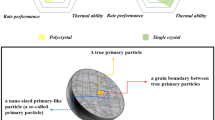Abstract
A highest Mg2+ ion conducting polycrystalline solid electrolyte was successfully realized by improving the characteristics of both grain bulks and grain boundaries simultaneously. The former improvement was achieved by making a solid solution to substitute cation site for higher valent one to create Mg2+ ion vacancies in grain bulks. The latter was realized by obtaining a composite in such a manner to microscopically deposit the insulating secondary phase in grain boundaries. By combining above mentioned two effects, the optimization of Mg2+ ion conductivity at around 800 °C was effectively achieved to reach the total Mg2+ ion conductivity of approximately 10−2 S·cm−1 which is applicable in a practical range.
Similar content being viewed by others
References
A.R. West, in: Solid State Chemistry and its Applications, John Wiley & Sons, Chichester, 1984, Chap. 13, p. 452.
T. Kudo and K. Fueki, in: Solid State Ionics, Kodansha, Tokyo, 1990, Chap. 9 and 10, p. 171.
S. Ikeda, M. Takahashi, J. Ishikawa and K. Ito, Solid State Ionics23, 125 (1987).
K. Nomura, S. Ikeda, K. Ito and H. Einaga, Bull. Chem. Soc. Jpn.65, 3221 (1992).
K. Nomura, S. Ikeda, K. Ito and H. Einaga, Solid State Ionics61, 293 (1993).
G. Dorner, H. Durakpasa, G. Fafilek and M.W. Breiter, Solid State Ionics53–56, 553 (1992).
K.W. Semkow and A.F. Sammells, J. Electrochem. Soc.135, 244 (1988).
G.C. Farrington and B. Dunn, Solid State Ionics7, 267 (1982).
R. Seevers, J. DeNuzzio, G.C. Farrington and B. Dunn, J. Solid State Chem.50, 146 (1983).
B. Dunn and G.C. Farrington, Mater. Res. Bull.15, 1773 (1980).
N. Imanaka, Y. Okazaki and G. Adachi, Chem. Lett. 1999, 939.
N. Imanaka, Y. Okazaki and G. Adachi, J. Mater. Chem.10, 1431 (2000).
N. Imanaka Y. Okazaki and G. Adachi, Electrochem. and Solid-State Letters3, 327 (2000).
R.D. Shannon, Acta Cryst.A32, 751 (1976).
Y. Kobayashi, T. Egawa, S. Tamura, N. Imanaka and G. Adachi, Chem. Mater.9, 1649 (1997).
C. Tubandt, Handb. exp. Physik7, 1 (1932).
Author information
Authors and Affiliations
Corresponding author
Rights and permissions
About this article
Cite this article
Imanaka, N., Okazaki, Y. & Adachi, G. Optimization of divalent magnesium ion conduction in phosphate based polycrystalline solid electrolytes. Ionics 7, 440–446 (2001). https://doi.org/10.1007/BF02373581
Received:
Accepted:
Issue Date:
DOI: https://doi.org/10.1007/BF02373581




